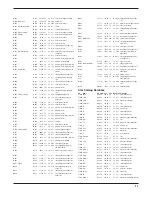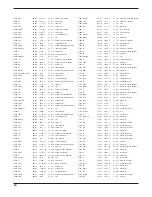
6
After Sky Wizard determines the transformation resulting
from star alignment, it displays a measure of how well the
alignment agrees with its star data. This “warp factor” is 0.0 for
perfect alignment, but an acceptable range is ±0.6. The dis-
play will show the warp for about 2 seconds. This represents
the error in degrees and tenths. Example:
WARP=+0.5
If the warp factor is greater than 0.6, check to be sure you
have correctly identified the setup stars and repeat the setup
operation. Make sure that your Startup Index Mark is exact.
Never assume, for example, the mechanical setting circles
are exact for the Dec.=0 index mark. Always double check the
accuracy of the index mark, especially on your first night out.
If the warps are larger than 10, check the encoder polarity
and encoder ratios on your install kit instructions. Always do
the
ENC TEST (Encoder Direction Test, see below) after
installing the Sky wizard, before you go out at night for the first
time. Note: if your telescope mount does not have the two
axes perfectly set at 90° apart, it may be impossible to reach
an acceptable warp factor. If this happens, correct the tele-
scope mount.
Enc test
Encoder test must be done after installing the Sky Wizard on
the telescope, and before going out at night for the first time.
This allows verification that the encoders are functional and
move the correct direction and amount. The unit of measure
is whole degrees.
The display shows RA on the left and Dec. on the right. For
an equatorial mount the display will show both
000 on the
right ascension axis, and
+000 on the declination axis. The
RA increases from 0 to 90 as you move toward the West 90
deg. The Dec. increases from 0 to +90 as you move the tele-
scope from the Equator to the North pole.
For an altitude/azimuth telescope mounting the display identi-
fies the first numbers
000 as the azimuth axis, and the second
numbers
+000 as the altitude axis. Azimuth should be 0° for
logical north, and increase to 90° for logical east. Altitude is
0° when horizontal and +90° when vertical. Motion of the
telescope will change the encoder angles.
ra/DEc
Displays right ascension and declination, which provides a
continuous display of telescope position. Example:
RA=0742
D=+28.1. This example shows a right ascension of 7 hours
and 42 minutes, and a declination of north 28.1 degrees.
Note: The final digit in the declination is in tenths of a degree.
catalog
This mode retrieves information from one of Sky Wizard’s six
separate catalogs. Select this mode by pressing MODE, then
either UP or DOWN until
CATALOG is displayed, then press
ENTER. Press the UP or DOWN arrow to select one of the cata-
logs, then press ENTER when the catalog you prefer is displayed.
Catalogs available (and typical display):
Star
catalog:
ST001
Messier
catalog:
M001
NGC
catalog:
NGC0001
IC
catalog:
IC0001
NEW (programmable) user’s catalog:
NEW01
The Planets catalog:
PLANETS
The first time a catalog is used the display will show its first
entry. For example, the Messier catalog displays
M001, which
happens to be the Crab Nebula. The
“M” will be blinking.
The
ST (Star) Catalog contains many interesting stars, dou-
ble stars and red stars including all of the alignment stars. The
complete list is included in the back of this manual. First look
up the object, select
CATALOG mode, choose ST , and enter
the index number using the arrow buttons to set the blinking
digit, pressing ENTER to advance to the next digit to be set.
Press ENTER after setting the last digit and the display will
show the coordinates. For the famous double star “Albireo” the
following information would appear on the display:
Example CATALOG display for selecting an object from the
star (
ST) list:
Enter number:
ST182
Coordinates:
0513+028
Description:
ST182 MAG=4.5 SIZE=7.0
RHO ORION COLORED DOUBLE STAR
The
MESSIER Catalog contains the full historical list of 110
objects identified by the famous French astronomer Charles
Messier. These objects are the most popular objects observed
by amateur astronomers. (The catalog list includes objects
now known to be duplicates or asterisms, which are identified
in the description.)
Select
CATALOG with the MODE button and press ENTER. If
you are already in
CATALOG, simply press the arrow buttons
to switch between the three groups and press ENTER. The
display will show
M001. Enter the desired value of the blinking
digit using the arrow buttons and press ENTER to advance to
the next digit. When the last digit has been set, press ENTER
and the display will show the M number. Press ENTER again
to show the coordinates for the selected object. Press ENTER
again for a scrolling description which includes magnitude,
popular name, constellation and description.
Example
CATALOG display for selecting an object from the
Messier (
M) list:
Catalog number:
M027
Celestial coordinates:
2000+227
Description:
M027 MAG=8.0 SIZE=480
DUMBBELL NEBULA VULPECULA
PLANETARY NEBULA IRREGULAR















